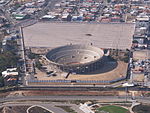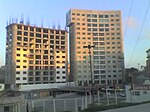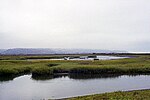Initial Point of Boundary Between U.S. and Mexico

The Initial Point of Boundary Between U.S. and Mexico (Monument No. 258) is the westernmost boundary marker on the international boundary between the United States and Mexico and as such has since its erection marked the southwestern corner of the Continental United States. According to the 1848 Treaty of Guadalupe Hidalgo, the initial border point is set as one marine league (three nautical miles) south of the southernmost point of San Diego Bay, and the border proceeds in a straight line towards the confluence of the Colorado River and Gila River. The significance of the monument is stated in the inscription on the west side of the original marble shaft: "Initial point of Boundary between the United States and Mexico, established by the Joint Commission, 10 October, A.D. 1849, Agreeably to the Treaty dated at the City of Guadalupe, Hidalgo, February 2, A.D. 1848. John B. Weller, U.S. Commissioner. Andrew B. Gray, U.S. Surveyor.
Excerpt from the Wikipedia article Initial Point of Boundary Between U.S. and Mexico (License: CC BY-SA 3.0, Authors, Images).Initial Point of Boundary Between U.S. and Mexico
Cantera, Tijuana
Geographical coordinates (GPS) Address Nearby Places Show on map
Geographical coordinates (GPS)
| Latitude | Longitude |
|---|---|
| N 32.534444444444 ° | E -117.12194444444 ° |
Address
Cantera
22504 Tijuana
Baja California, Mexico
Open on Google Maps







